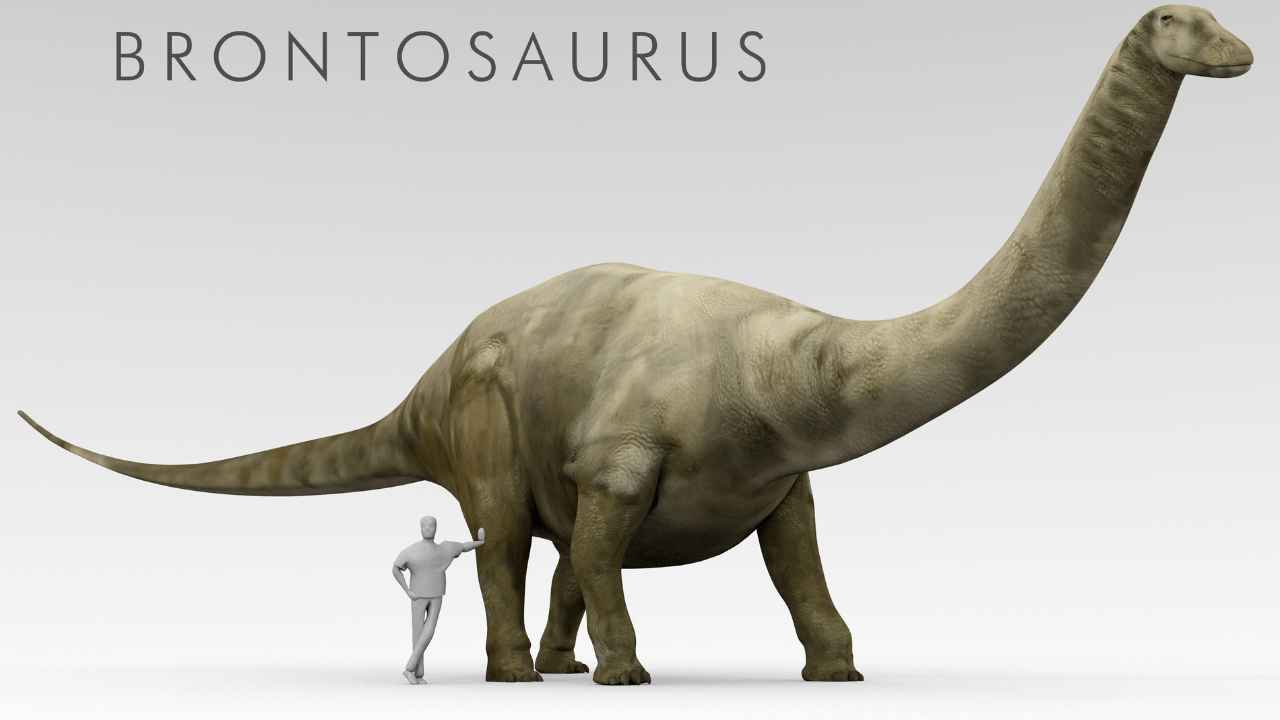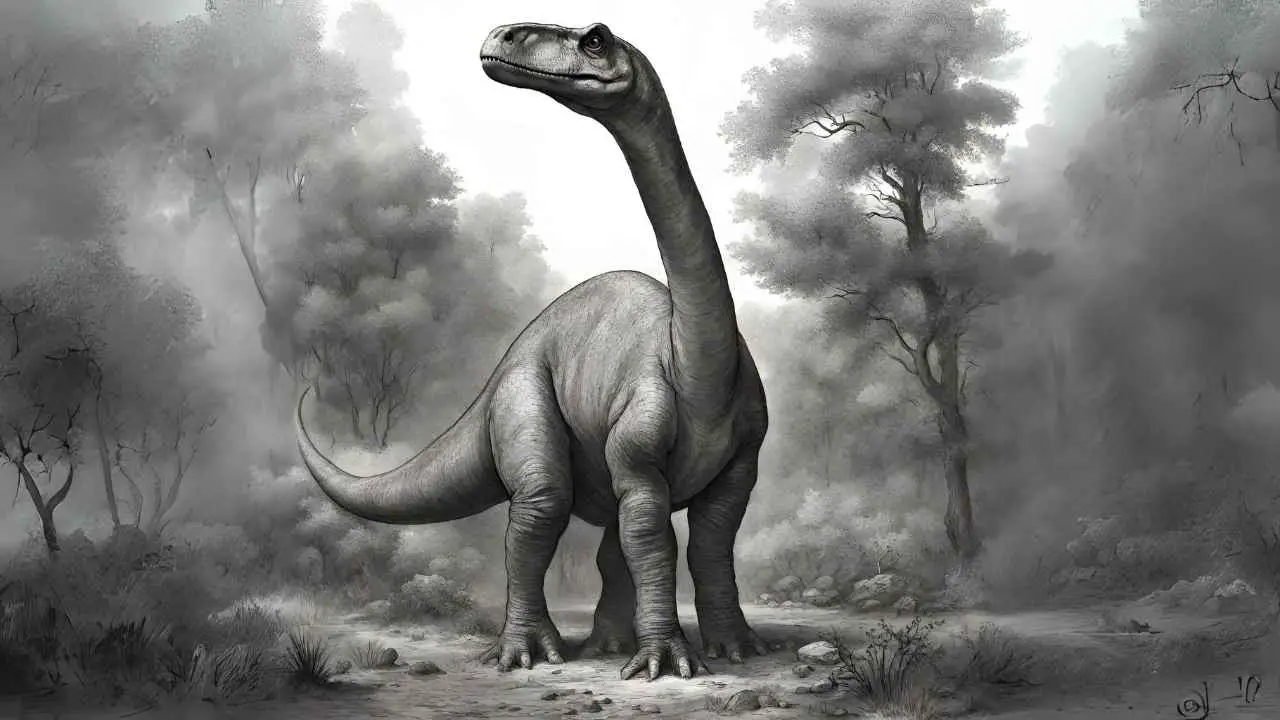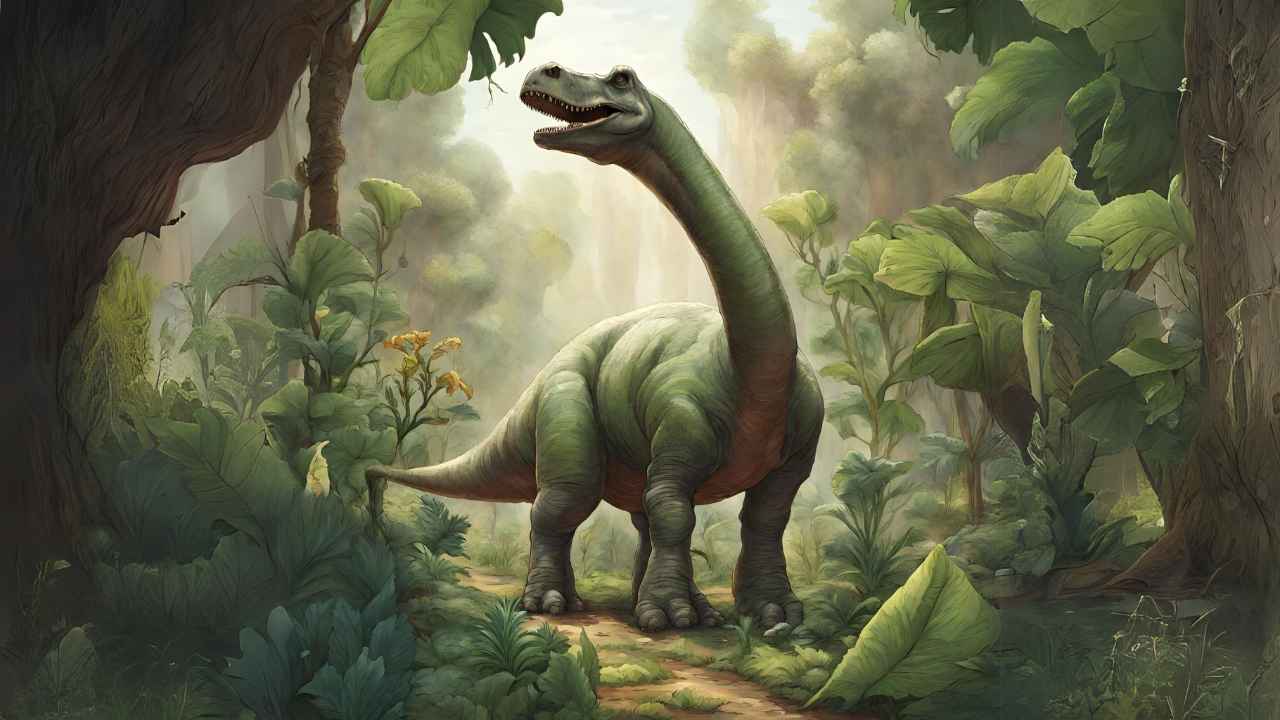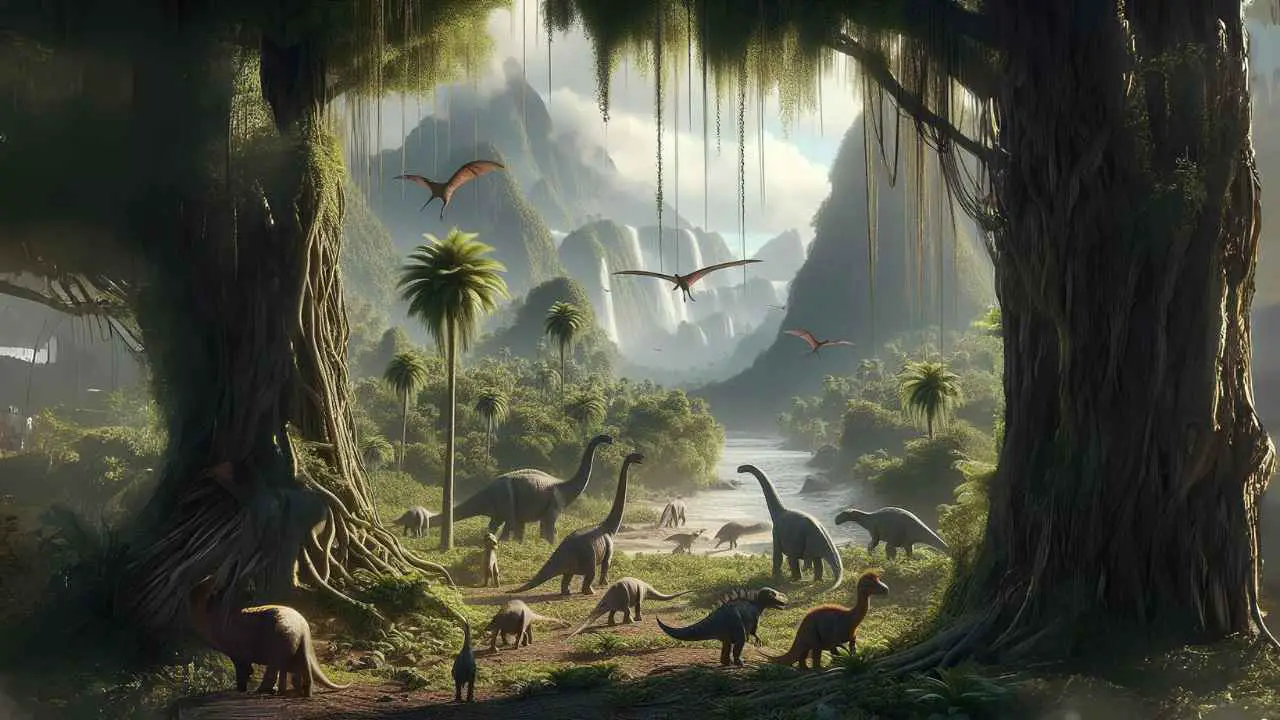Once upon a time, in a world very different from ours, there lived a colossal creature known as the Brontosaurus. This magnificent dinosaur, whose name means “Thunder Lizard,” has captured the hearts and imaginations of children and adults alike for generations. The Brontosaurus, with its massive size and long, sweeping tail, stands as one of the most iconic members of the dinosaur kingdom.
In the lush, green landscapes of the Late Jurassic period, over 150 million years ago, the Brontosaurus roamed the Earth. Its enormous body and long neck, which it likely used to reach high into the trees for food, make it one of the most easily recognizable dinosaurs. Despite its intimidating size, the Brontosaurus was a gentle giant, moving slowly through the prehistoric forests and plains it called home.
The Brontosaurus has not only been a subject of fascination in the scientific community but has also played a starring role in books, movies, and cartoons, further cementing its status as a beloved and well-known dinosaur. Its story is not just about its size and strength but also about the journey of discovery and understanding that scientists have undertaken over the years.
In this journey through time, we will explore the fascinating world of the Brontosaurus. From its discovery and the mysteries surrounding its existence to its lifestyle and the legacy it has left behind, we will delve into the life of this incredible dinosaur. So, let’s step back in time and uncover the story of the Brontosaurus, a true marvel of the prehistoric world.
Brontosaurus Facts For Kids
What is a Brontosaurus?

The Brontosaurus, often referred to as the ‘Thunder Lizard’, is a name that resonates with the image of a colossal, majestic creature. This dinosaur, belonging to the group of long-necked, plant-eating giants known as sauropods, was one of the largest animals to ever walk the Earth. But what exactly made the Brontosaurus stand out among its prehistoric peers?
A Glimpse into the Size and Appearance
The Brontosaurus was an awe-inspiring sight. Adults could reach lengths of up to 72 feet (about 22 meters) and weigh as much as 15 tons (about 13,600 kilograms). This is roughly equivalent to the weight of three large elephants! The most striking feature of the Brontosaurus was its incredibly long neck, which it used to reach high vegetation. This neck extended from a massive body, supported by four sturdy, pillar-like legs, and ended in a long, whip-like tail.
In appearance, the Brontosaurus had a small head in comparison to its enormous body. Its nostrils were located on the top of its head, and it had peg-like teeth suited for stripping leaves and vegetation. The skin of the Brontosaurus was likely similar to that of other sauropods, with a tough, possibly scaly texture.
Distinguishing the Brontosaurus from Its Cousins
While the Brontosaurus shared the Earth with other sauropods, there were distinct differences that set it apart. One of its closest relatives, the Apatosaurus, was often confused with the Brontosaurus. For many years, scientists debated whether they were, in fact, the same species. However, it was later determined that there were enough differences in their bone structure, particularly in the neck and vertebrae, to classify them as separate species.
Another similar dinosaur, the Diplodocus, shared the same habitat as the Brontosaurus. The Diplodocus, however, had a more slender build and an even longer tail and neck. Its vertebrae had a different structure, with lighter, air-filled bones, allowing for a more elongated shape.
History of Discovery

The discovery of the Brontosaurus is a fascinating tale that takes us back to the late 19th century, a time when the field of paleontology was in its infancy and the race to discover new dinosaurs was in full swing. This period, known as the Bone Wars, saw two rival paleontologists, Othniel Charles Marsh and Edward Drinker Cope, fiercely competing to find and name new prehistoric creatures.
The Initial Discovery
It was in this competitive atmosphere in 1877 that the first Brontosaurus fossils were unearthed in the Morrison Formation of western North America by Marsh’s team. Marsh named this new dinosaur Brontosaurus excelsus, meaning “noble thunder lizard.” The initial discovery included a few vertebrae, a pelvis, and some limb bones. However, the crucial element missing was the skull. Marsh, in his haste to classify the find, mistakenly placed a skull of another dinosaur, believed to be from a Camarasaurus, on the Brontosaurus skeleton.
The Apatosaurus-Brontosaurus Confusion
In 1877, two years before the discovery of the Brontosaurus, Marsh had already discovered and named another dinosaur, the Apatosaurus ajax. This dinosaur was similar in size and appearance to the Brontosaurus but was based on more incomplete remains. As more fossils were uncovered, the lines between the Apatosaurus and Brontosaurus became blurred. Many in the scientific community started to suspect that they were, in fact, the same species, with Brontosaurus being a more mature form of Apatosaurus.
Resolving the Identity Crisis
This suspicion was confirmed in the early 20th century when more complete fossils were found, allowing for better comparisons. In 1903, paleontologist Elmer Riggs stated that the Brontosaurus was not different enough from the Apatosaurus to warrant its own genus. As a result, the name Brontosaurus was dropped in favor of Apatosaurus, as it had been named first.
However, the story didn’t end there. In 2015, a comprehensive study re-evaluated the fossils and found significant differences between the two dinosaurs, particularly in the shape and size of their neck bones. This led to the Brontosaurus being reinstated as its own distinct genus. The Brontosaurus had finally reclaimed its rightful place in the dinosaur pantheon, not just as a pop culture icon but as a scientifically recognized and distinct species.
Habitat and Lifestyle of Brontosaurus

The Brontosaurus, a giant of the Jurassic period, thrived in an environment that was vastly different from our own. Understanding where this magnificent creature lived and how it spent its days offers us a glimpse into a long-lost world, teeming with diverse life forms and lush vegetation.
The Brontosaurus Habitat
The Brontosaurus roamed the Earth approximately 150 million years ago during the Late Jurassic period. Its fossils have been predominantly found in the Morrison Formation, a vast sedimentary rock sequence that spans several states in the modern-day United States, including Colorado, Utah, Wyoming, and Oklahoma. This region, during the Jurassic period, was a vastly different landscape, characterized by a semi-arid environment with distinct wet and dry seasons.
The Morrison Formation was home to a variety of ecosystems, ranging from river floodplains to forested areas. This diversity of habitats provided the Brontosaurus with an abundant supply of food and a suitable environment for its massive size. The area was dotted with large, slow-moving rivers and interspersed with coniferous forests, fern prairies, and lush vegetation.
Diet and Feeding Habits
As a herbivore, the Brontosaurus’s diet consisted primarily of plant material. Its long neck would have been an advantageous adaptation, allowing it to reach high into the trees to feed on foliage that other herbivores couldn’t reach. It is believed that the Brontosaurus, like other sauropods, had a diet that included leaves from conifers, cycads, ginkgoes, and possibly ferns.
The Brontosaurus’s teeth were well-suited for stripping leaves off branches, but they were not adapted for chewing. This suggests that the Brontosaurus swallowed its food whole and relied on its massive gut to process and break down the plant material. The sheer volume of food required to sustain such a large creature meant that the Brontosaurus likely spent a significant portion of its time eating.
Lifestyle and Behavior
While there is still much to learn about the behavior of the Brontosaurus, it is generally believed that, like many other sauropods, they were social animals. They may have lived in herds, which would have provided some level of protection against predators. Living in groups could also have been beneficial for younger, more vulnerable members of the species.
The slow-moving nature of the Brontosaurus, combined with its massive size, suggests a relatively sedentary lifestyle. However, they would have been capable of undertaking long migrations in search of food, especially in response to the changing seasons and the availability of vegetation.
Physical Characteristics of Brontosaurus

The Brontosaurus, a true giant of the Jurassic era, was distinguished by a range of physical characteristics that not only set it apart from other dinosaurs but also supported its lifestyle as a large herbivore. Let’s delve into the specifics of its physical features, size, weight, and distinctive attributes.
Size and Weight
The Brontosaurus was one of the largest land animals to have ever existed. On average, these dinosaurs reached lengths of about 72 feet (22 meters), comparable to the length of two city buses end-to-end. In terms of height, they stood around 15 feet (4.5 meters) tall at the hips. The weight of a fully grown Brontosaurus is estimated to have been around 15 tons (13,600 kilograms), which is akin to the combined weight of three large African elephants.
Distinctive Physical Features

Long Neck and Tail:
The most striking feature of the Brontosaurus was its incredibly long neck, which could be up to half the total body length. This neck extended from a massive, barrel-shaped body and was balanced by an equally long and heavy tail. This tail, which could stretch just as long as the neck, helped in maintaining the dinosaur’s balance and possibly played a role in communication or defense. The combination of the long neck and tail gave the Brontosaurus a distinctive, elongated appearance, making it one of the most recognizable dinosaurs of the Jurassic period.
Head:
Despite its enormous body, the Brontosaurus had a relatively small head. Its skull was modest in size with a blunt snout. The nostrils were positioned on top of the head, and it had a set of relatively simple, peg-like teeth, which were perfect for stripping leaves and soft vegetation.
Body:
The body of the Brontosaurus was robust and stocky. Its chest was wide and deep, housing a large digestive system necessary for processing large amounts of plant material.
Limbs:
Supporting its massive body were four strong, columnar legs. The front legs were slightly shorter than the hind legs, giving its back a gentle sloping appearance. Despite their size, the feet of the Brontosaurus were not overly broad, with each foot having five toes, where the first toe on each foot had a large claw.
Skin:
While direct evidence of Brontosaurus skin is scarce, it is believed, based on related species, that they had a skin texture similar to that of other sauropods – possibly scaly, but not as heavily armored as some other dinosaur species.
Behavior and Social Life of Brontosaurus

The behavior and social life of the Brontosaurus, while not completely understood, offer intriguing insights into how these colossal creatures might have interacted with one another and their environment. Let’s explore what is known and hypothesized about their social behavior and group dynamics.
Social Behavior
Herd Behavior: Paleontologists believe that the Brontosaurus, like many other sauropods, was likely a herd animal. This assumption is based on the discovery of fossilized tracks and the social behavior of modern large herbivores. Living in herds would have provided numerous benefits, including protection against predators, increased efficiency in finding food, and assistance in rearing young. Herd behavior also implies a certain level of social interaction, which could have been crucial for survival.
Evidence of Herding: Fossilized footprints have been found showing multiple sauropods moving in the same direction, suggesting coordinated movement. While these tracks cannot be attributed to Brontosaurus specifically, they do provide evidence that herding was a common behavior among large sauropods.
Movement and Migration
Traveling in Groups: If Brontosaurus moved in herds, it is likely that they migrated together in search of food and water. Their large size would have required vast amounts of vegetation, possibly necessitating movement across great distances to find enough food to sustain the herd.
Territorial Behavior: There is little evidence to suggest that Brontosaurus were territorial. Given their size and the nature of their diet, it is more likely that they had to continually move to new areas to find sufficient food, rather than defending a specific territory.
Communication
While the exact methods of communication among Brontosaurus are unknown, it is plausible that they used a combination of vocalizations, body language, and possibly vibrations caused by their movement to communicate with each other. These forms of communication would have been essential for maintaining herd cohesion, especially while migrating.
Parental Care and Rearing of Young
The social structure of the Brontosaurus might have included communal care for the young. This behavior, observed in some modern herd animals, could have provided the young Brontosaurus with a higher chance of survival, as multiple adults could protect and guide them.
Interesting Facts About Brontosaurus

The Brontosaurus, a giant of the Jurassic era, is a dinosaur that continues to fascinate not just scientists but also the general public. Beyond its immense size and iconic status, there are several lesser-known and intriguing aspects of this ancient creature. Let’s explore some of these interesting facts and draw comparisons with modern animals for a better understanding.
Name Meaning: The name ‘Brontosaurus’ translates to ‘Thunder Lizard’, a reference to the belief that the ground would shake as it walked. This name captures the essence of its immense size and the impact it would have had on its environment.
Tail as a Weapon: The Brontosaurus had a long, whip-like tail which could have been used as a defensive weapon. It is theorized that this tail could crack like a whip, potentially deterring predators or communicating with other Brontosauruses.
Nasal Mysteries: The Brontosaurus had its nostrils located at the top of its head, which was unusual. There is ongoing debate among scientists about the function of this feature, with theories ranging from helping to keep water out while feeding on aquatic plants to playing a role in resonance for sound production.
Growth Rate: Despite their enormous size, Brontosauruses grew relatively quickly. Studies of their bone structure have revealed growth rings, similar to those in trees, indicating rapid growth during their juvenile stages.
Longevity: While the exact lifespan of a Brontosaurus is unknown, based on its size and growth patterns, it is speculated that they could have lived for up to a century, much longer than most modern land animals.
Comparisons with Modern Animals
Size Comparison: The Brontosaurus was longer than a basketball court and weighed as much as four adult male African elephants combined. This comparison helps in visualizing the sheer size of these creatures.
Neck Comparison: The long neck of the Brontosaurus is often compared to that of a giraffe, the modern animal with the longest neck. However, the Brontosaurus’s neck was much longer and more muscular, adapted to support its massive size and reach high vegetation.
Lifestyle Comparison: In terms of lifestyle, the Brontosaurus can be compared to modern-day elephants. Like elephants, Brontosauruses were likely social animals that moved in herds, had a herbivorous diet, and played a significant role in shaping their ecosystem.
Vocalization Theories: Some scientists speculate that, like whales, the Brontosaurus might have used low-frequency sounds to communicate over long distances. This theory is based on the structure of their nasal passages and resonating chambers.
Fossils and Research
The study of Brontosaurus fossils is a continually evolving field, with each discovery offering new insights into this majestic dinosaur. The journey of unearthing and understanding Brontosaurus fossils spans over a century, with significant findings still being made today.
Where Brontosaurus Fossils Have Been Found
Morrison Formation: The majority of Brontosaurus fossils have been discovered in the Morrison Formation, a sequence of Upper Jurassic sedimentary rock in the Western United States. This formation covers parts of Colorado, Utah, Wyoming, and Oklahoma. The Morrison Formation is renowned for being one of the most fertile sources of Late Jurassic dinosaur fossils.
Other Locations: While the Morrison Formation is the primary source, Brontosaurus fossils have also been unearthed in other parts of North America. Each of these locations provides a slightly different context, offering clues about the variations in habitat and possibly even slight differences in species.
Ongoing Research and Recent Discoveries
New Species Identification: The field of paleontology is continually revising and updating its understanding of dinosaurs, including the Brontosaurus. Recent studies have led to the identification of different species within the Brontosaurus genus, each with slight variations in size and anatomy.
Advanced Technology in Research: Modern technology has revolutionized the study of fossils. Techniques like 3D scanning and computer modeling allow paleontologists to reconstruct skeletons and simulate the movement and behavior of the Brontosaurus with greater accuracy than ever before.
Paleoecology: Researchers are not only interested in the bones of the Brontosaurus but also in the world it lived in. Studies of the surrounding rock, fossilized plants, and other dinosaur species from the same area help scientists piece together the paleoecology of the Brontosaurus, giving insights into its diet, behavior, and interactions with other species.
Growth and Development Studies: Analysis of bone structure and growth patterns provides information on how the Brontosaurus grew and aged. This research is crucial in understanding the life cycle of these dinosaurs, from hatchlings to full-grown adults.
Soft Tissue Research: While soft tissues are rarely fossilized, any discovery of such materials can provide invaluable information about the muscle structure, skin, and possibly even the coloration of the Brontosaurus.
Brontosaurus in Popular Culture
The Brontosaurus, with its massive size and distinctive silhouette, has long been a staple of popular culture, captivating audiences in various forms of media and entertainment.
Movies and Television
The Brontosaurus has been featured in numerous films and TV shows, often depicted as a gentle giant. From classic cinema to modern animations, it has been a symbol of the prehistoric world’s wonder and mystery. Its appearances range from background roles in dinosaur-themed movies to being a central character in children’s shows.
Books:
In literature, the Brontosaurus often appears in children’s books, where it is used to spark interest in history and science. It also features in educational materials as an example of sauropod dinosaurs, helping to teach about the Earth’s geological past.
Media and Toys:
The image of the Brontosaurus is widespread in media, from cartoons to educational documentaries. Toy models of Brontosaurus are popular among children, further cementing its place in popular culture.
Why They Capture the Imagination of Children
Size and Scale: The sheer size of the Brontosaurus is awe-inspiring, especially to children. Its gigantic stature makes it a subject of fascination and wonder.
Gentle Giant Persona: Often portrayed as a peaceful herbivore, the Brontosaurus embodies the ‘gentle giant’ archetype, making it approachable and endearing in the eyes of children.
Symbol of a Bygone Era: The Brontosaurus represents a mysterious world that existed long before humans, sparking curiosity about life on Earth millions of years ago.









